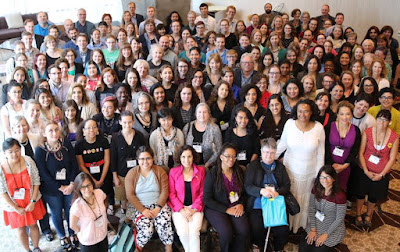| Images Source: Link below |
Topics: Astrophysics, Black Holes, Einstein, General Relativity, Diversity in Science, Women in Science
Black-Hole Hunter Takes Aim at Einstein, Joshua Sokol, Quanta Magazine
| Images Source: Link below |
Topics: Astrophysics, Black Holes, Einstein, General Relativity, Diversity in Science, Women in Science
Black-Hole Hunter Takes Aim at Einstein, Joshua Sokol, Quanta Magazine
 |
| The Women in Astronomy IV conference was held in Austin, Texas, following the American Astronomical Society meeting in June. Credit: J. Hellerman, NRAO/AUI/NSF |
CONSTANT "RE-REGURGITATION"....NO NEW IDEAS, and too Arrogant and Selfish to Breed and Establish any "BOLD/NEW/EXCITING" Franchise Brands and IDEAS; Hollywood has some "Changing to DO!"
CONSTANT "RE-REGURGITATION"....NO NEW IDEAS, and too Arrogant and Selfish to Breed and Establish any "BOLD/NEW/EXCITING" Franchise Brands and IDEAS; Hollywood has some "Changing to DO!"
WANT to SEE SOME "ALL NEW ORIGINAL" Franchise Brands and IDEAS; HERE WE ARE!
WE do NOT "COPYCAT" off of Marvel/DC/DISNEY/IMAGE or Others; "YES", Those GIANTS "INSPIRED/INSPIRE US"; BUT we Create/Write and Develop OUR OWN NEW/EXCITING/COPYRIGHTED" Franchise Brands and Characters/////
we "HONOR" WOMEN & MOMS, and MILITARY Females with our NEW, EXCITING "G.i.J.i.M.O.M." Series: http://thesiborg.com/ http://familymediasite.com/ http://tdmcomics.com/ http://post-up.me/
http://www.hollywoodreporter.com/…/box-office-hollywoods-fr…
Box Office: Hollywood's Franchise Crisis Worsens Over July Fourth
 |
| Image Source: Aventurine |
The day has come! It's been two years (real world time and book time) since we last heard about the superpowered teens, the Elementals, working to protect their world. Now, they are focused on stopping the Prudence kids from enacting their worst plan yet: bringing back A.G.
This book of diverse and intersectional superheroes is all about showing what happens when narratives get twisted, and how important it is to trust in yourself. The Elementals learn a lot about the world in this sequel, and that lesson takes you on an adventure you won't forget!
The book is available NOW on Amazon, Kindle, CreateSpace, and of course my website. Get your copy today and support the diverse superhero movement!
 |
| Image Source: NYT |
Topics: Climate Change, Environment, Geophysics, Weather
An Iceberg the Size of Delaware Just Broke Away From Antarctica, Jugal K. Patel and Justin Gillis, New York Times
 |
| NASA’s Solar Dynamics Observatory spacecraft captured this view of a sunspot rotating into view between July 5 and 11, 2017. (Source: NASA’s Goddard Space Flight Center/SDO/Joy Ng, producer) |
Incredible video shows northern lights shining above Michigan’s Mackinac Bridge during the early morning hours. https://t.co/sroBjEAofA pic.twitter.com/9efeFd5K34— ABC News (@ABC) July 18, 2017
 |
| Image Source: Business Insider |
Topics: Geophysics, Politics, Research, Science
 |
| Wikipedia: Doomsday |
The underlying physics of natural hazards, Physics World Multimedia
In honor of the release of my second novel, Return of A.G., next week, I'm running a sale of all the Legend of the Orange Scepter t-shirts and posters! Check out the website store and support the Elementals and the diverse superhero movement. There's something for everybody; just look at he stuff above!
 |
| Image Source: Cagle Comics |
Topics: Civics, Existentialism, Politics
*****
Sun Tzu, The Art of War
Related links:
1. Exxon Fined $2 Million for Violating Russia Sanctions While Tillerson Was CEO, Inae Oh, Mother Jones
2. Why the GOP and the Bernie Left Don’t Care About “the Russia Story”, Sasha Stone and Ryan Adams, Extra News Feed
3. Party of Apocalypse, Essay
 |
| The cosmos can be considered as a collider for human to access the results of particle physics experiments at ultimate high energies. Credit: Department of Physics, HKUST |
Topics: Electrical Engineering, Nanotechnology, Semiconductor Technology
Colloidal metal nanoparticles make Coulomb transistor, Belle Dumé, Nanotech Web
The Priestess: Stones, Conflict and Legacy concludes as the Princess Meru waits as final preparations to defend Sea City from an impending Tenaree attack. She won't 'wait' long for within the hour, Meru will be introduced to her betrothed, Prince Tinochika of the Island Nation! However, as hour grows short Meru is conflicted as to what her future entails. Against her better judgement, Meru summons the foreign Amoosu, Mjarga the Witch of Aesirfjord to divine her future. With war and marriage imminent, the Princess must know if there is hope for her love of the Valley Knight to bear fruit! It is a dangerous question and having seen the Amoosu's power, Meru may well not like what she sees if Mjarga is willing to help her at all! These questions as with others will be revealed in the conclusion of 'The Priestess: Stones, Conflict and Legacy' Part 6!
The Second Saga continues as the Aesir traitor Turid is confronted by Chief Svengald! Can the Chief reach his former subject through the brutal conditioning Turid endured at the hands of the Red Spirit? What can even he learn from a fanatic? Will his new 'sight' granted by the mighty sea serpent 'Sir Fish' be successfully brought to bear against the power of a goddess? Meanwhile, the Valley Knight must bring newly arrived Prince Tinochika up to speed concerning plans to defend Sea City from the Tenaree one day away! He must do this and stand aside for the Prince to take Princess Meru as bride. Can he do such a thing after professing love for her? Even so, how will this affect the Priestess? All will be revealed in, 'The Priestess: Stones, Conflict and Legacy' Part 5!
 |
| Image Source: Giphy.com |
Topics: Existentialism, Humor, Politics
Other than...
1. How Much More Absurdity Can You Handle? Charles P. Pierce, Esquire Magazine
2. Trump Lawyer Marc Kasowitz Threatens Stranger in Emails: ‘Watch Your Back , B---h’, Justin Elliott, ProPublica
I want AFROcreators to produce more stories, movies, comics, art, and music about the "Great War of Africa."
The BSFS is a good place for AFROFuturistic writers to gain inspiration. Here, we can share, critique and support as well as promote each other's works. Let's put out more ideas for education, entertainment, and enlightenment. Let's consider the Great War of Africa as a shared theme.
The modern cinema is crammed with European War stories: Wonder Woman, Captain America, Nick Fury and on and on. But the Great War of Africa is mostly absent. Hollywood spent millions on the movie "Dunkirk, " but some of the greatest WWII battles were fought in Northern Africa.
The Great War of Africa began in the late 1800s when Europeans sought to steal the treasures of the Mother Land. There were many heroes, villains, and survivors worthy of prominence in our speculative arts. Real superheroes. We have much more than Black Panther.
These stories have to be told.
Who writes and produces those works? We should. We must. We will do this. And, many of us are acting on it now.
The Red Spirit broods deep within an extinct volcano as she licks her wounds after being thwarted by a new enemy. An enemy which has proven resourceful and capable of wounding even her, a semi-divine being! Brooding will not be enough to make her plans to conquer the Nation of Palm and all the surrounding kingdoms. It will take clear focus to stick with her plans though the prospect of an individual mortal or god capable of killing her is a sobering development.
A surprise visit by an uninvited guest, has the potential to bring everything back into focus for the Red Spirit and potentially give her greater means to accomplish her 'ultimate goal'. Or will her guest bring ill tidings for the coming attack on Sea City? All will be revealed in, 'The Priestess: Stones, Conflict and Legacy' Part 3!
An interesting article about 'The Queen of Dark' a famous South Sudanese model living in Minnesota. You can read about it here. http://tinyurl.com/yb7on2ws
When I wrote Super Humanity, I included some jokes about the characters' blackness and American society's almost 'rejection' of those with very dark skin from the entertainment industry. It's become a running joke in some ways. You've heard them all before- too black for music videos, for one.
If my books get made in movies, I'd like her in to be in it. Probably not as a star, since my main characters are much younger.